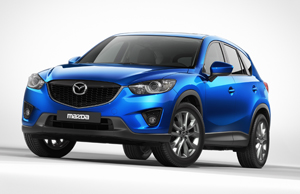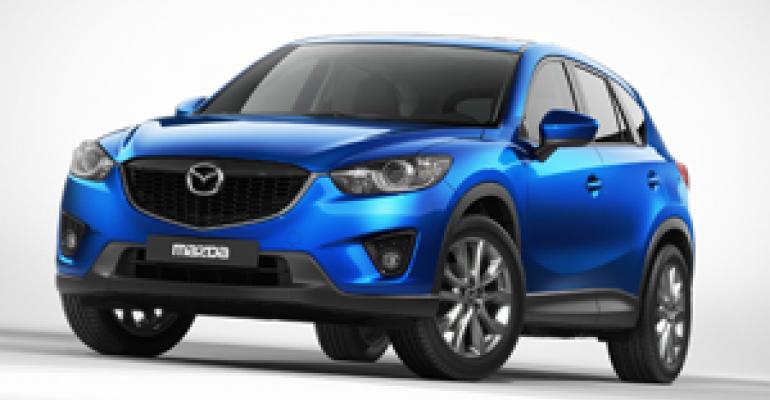
REYKJAVIK, Iceland – Mazda may be arriving late to the compact cross/utility vehicle segment, but the all-new CX-5 is bound to make a dent when it goes on sale in most markets, including the U.S., after the first of the year.
As a styling exercise, the CX-5 could get lost in the crowd or confused with its bigger sibling, the CX-7. The interior carries over many familiar Mazda design cues, including high-gloss piano black trim used sparingly, but does not necessarily raise the bar for the segment.
What makes the CX-5 compelling are two sophisticated new 4-cyl. engines – one turbodiesel and one direct-injection gasoline – and two redesigned 6-speed transmissions, manual and automatic.
These are the primary building blocks of Mazda’s new SkyActiv product strategy, which takes a more holistic approach to vehicle design by integrating lightweight suspension components and underbody with advanced powertrains and electric power steering to achieve world-class safety and fuel economy, while reinforcing the brand character.
Hand-built prototypes driven by journalists here in advance of the CX-5’s worldwide debut at the upcoming Frankfurt auto show in September suggest the SkyActiv suite of technologies is more than a clever marketing ploy.
The engines and transmissions are impressively proficient in moving these 5-passenger CUVs along the undulating terrain here.
The four prototypes are powered by the 2.2L diesel mated with the 6-speed manual and automatic, as well as the 2.0L gasoline I-4 with the same transmissions.
Each combination is stellar in its own right, capable of making long, flat stretches of desolate Arctic highway downright euphoric. Torque is readily available at low- and mid-range engine speeds.
![<link rel="stylesheet" href="http://subscribers.wardsauto.com/galleries/files/lightbox.css" type="text/css" media="screen" />
<script src="http://subscribers.wardsauto.com/galleries/files/prototype.js" type="text/javascript"></script>
<script src="http://subscribers.wardsauto.com/galleries/files/scriptaculous.js?load=effects" type="text/javascript"></script>
<script src="http://subscribers.wardsauto.com/galleries/files/lightbox.js" type="text/javascript"></script>
<p><a href="http://subscribers.wardsauto.com/galleries/2011/mazda-gallery1.jpg" rel="lightbox[plants]" title="C5-5 styling similar to larger CX-7.">View Photo Gallery</a></p>
<a href="http://subscribers.wardsauto.com/galleries/2011/mazda-gallery1.jpg" rel="lightbox[plants]" title="C5-5 styling similar to larger CX-7."></a>
<a href="http://subscribers.wardsauto.com/galleries/2011/mazda-gallery2.jpg" rel="lightbox[plants]" title="CX-5 interior carries over familiar Mazda design cues."></a>
<a href="http://subscribers.wardsauto.com/galleries/2011/mazda-gallery4.jpg" rel="lightbox[plants]" title="CX-5 prototype snakes way alongside whale fjord amid West Blue Basalt mountains outside Reykjavik. "></a>
<a href="http://subscribers.wardsauto.com/galleries/2011/mazda-gallery5.jpg" rel="lightbox[plants]" title="Mazda CX-5 prototype wrapped in heavy camouflage tape for test drives. "></a>
<a href="http://subscribers.wardsauto.com/galleries/2011/mazda-gallery6.jpg" rel="lightbox[plants]" title="Mazda engineers prepare CX-5 prototype for test drives. "></a>](http://subscribers.wardsauto.com/images/2011/08/Mazda-cx5-exterior.jpg)
One of the few criticisms, excessive wind and road noise, may have more to do with the quality and consistency of the paved roadways, as well as heavy camouflage tape applied to side-view mirrors and exterior body panels.
Three of the test cars are tuned for European specification, while the fourth is intended for Russia. That vehicle, with a gasoline-powered I-4 mill, 4-wheel drive, 6-speed automatic and 19-in. wheels, caps output at 150 hp and 153 lb.-ft (208 Nm) of torque to avoid Russian import duties.
The front-wheel-drive European-spec gasoline CX-5 with a 6-speed manual, benefits from an additional 15 hp and slightly more torque on paper. But the real-world advantage on the road over the Russian model is not noticeable.
About 80% of gas-powered, automatic CX-5s for the European market are expected to sell in Russia.
The “Sky-G” gasoline I-4 is a pleasure to drive, revving freely beyond 6,000 rpm in boisterous runs at wide-open throttle, yet going about its business in routine driving closer to 2,000 rpm. The engine never feels overtaxed and delivers an exhaust note that can be either sporty or sedate.
The gasoline engine achieves an unusually high compression ratio of 14.0:1, which boosts efficiency and helps yield a 15% increase in torque and 15% reduction in fuel consumption, compared with Mazda’s current MZR 2.0L gasoline I-4.

Another key enabler in the gasoline engine is a uniquely routed “4-2-1” exhaust manifold, which creates packaging challenges but enhances efficiency by reducing combustion temperatures.
The first U.S. vehicle to get the Sky-G gasoline engine is the refreshed Mazda3 subcompact, which goes on sale in October. But it will achieve a lower compression ratio of 12.0:1 because the new exhaust manifold will not fit on the existing vehicle.
When the 4-2-1 exhaust system arrives in the all-new CX-5 due in the U.S. in early 2012, the compression ratio will be 13.0:1 – slightly lower than the European spec because of lower octane levels in regular unleaded U.S. fuel, Mazda sources say.
The diesel engine meets global emissions regulations without requiring expensive urea additives in the exhaust stream to scrub away oxides of nitrogen, thanks to the world’s lowest diesel compression ratio of 14.0:1. A ceramic diesel particulate filter is all that is necessary.
The lower compression ratio reduces stress on internal engine parts, which have been re-engineered for lighter weight.
Overall, the diesel engine, which also gets an aluminum block, weighs 231 lbs. (105 kg), a 10% improvement over Mazda’s current iron-block 2.2L diesel, and fuel consumption is 20% better.
There’s a manufacturing advantage, as well. Both the new gasoline and diesel engines share similar components and are built on one of Mazda’s two engine-assembly lines in Hiroshima, Japan. Mazda powertrain engineers are not aware of any other auto maker building both diesel and gas engines on the same line.
On the road, the diesel sounds smooth and composed and happily revs close to the 5,200-rpm redline, due to a new Honeywell-supplied 2-stage turbocharger that boosts torque at both low and high engine speeds. Both diesels are equipped with all-wheel drive.
In driving all four vehicles around a hvalfjordur (whale fjord) surrounded by the West Blue Basalt mountains, the trip computers revealed impressive fuel economy.
This includes: 36 mpg (6.5 L/100 km) with the manual-equipped diesel; 32 mpg (7.4 L/100 km) with the diesel and automatic; 29 mpg (8 L/100 km) with the manual-equipped gas engine; and 25 mpg (9.5 L/100 km) for the Russian-spec gasoline/automatic combo.
U.S. specs for the CX-5 arriving in early 2012 will be revealed at the Los Angeles auto show in November. Only the gasoline engine will be offered initially. The diesel will come within the next two years, but Mazda does not specify in which vehicle.
It’s worth noting all four prototypes have stop/start technology to save fuel when the engine is idling. The system is very smooth in restarting the engine without the slightest hiccup.
The new 6-speed automatic transmission also does its job well in both the gasoline and diesel applications, intuitively knowing the proper gear, depending on throttle input and driving style. Compared with Mazda’s current 5-speed automatic, the new gearbox improves fuel efficiency up to 7%.
The CX-5 arrives as the Tribute CUV goes away; production ended in June. Mazda hopes the CX-5 will compete ably with the Volkswagen Tiguan, Chevrolet Equinox, Honda CR-V, Toyota RAV4, Hyundai Tucson, Kia Sportage and Nissan Rogue.
The prototypes driven here are far from market-ready, with many interior surfaces still unfinished. But mechanically, Mazda’s newest compact CUV suggests the SkyActiv approach will emerge as a prime example of successful vehicle integration.




